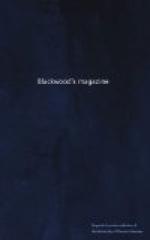But the ruins even now remaining of the fortifications
and publick works constructed in Aden by the Ottomans
during their tenure of the place, are on a scale which
not only proves how fully they were aware of the importance
of the position, but gives a high idea of the energy
with which their resources were administered during
the palmy days of their power, when such vast labour
and outlay were expended on the security of an isolated
stronghold at the furthest extremity of their empire.
The defences of the town, even in their present state,
are the most striking evidence now existing of the
science and skill of the Turkish engineers in former
times; and, when they were entire, Aden must have
been another Gibraltar. “The lines taken
for the works,” says a late observer, “evince
great judgment, a good flanking fire being every where
obtained; no one place which could possibly admit of
being fortified has been omitted, and we could not
do better than tread in the steps of our predecessors.
The profile is tremendous.” A supply of
water (of which the peninsula had been wholly destitute)
was secured, not only by constructing numerous tanks
within the walls, and by boring numerous wells through
the solid rock to a depth of upwards of 200 feet,
[38] but by carrying an aqueduct into the town from
a spring eight miles in the country, the reservoir
at the end of which was defended by a redoubt mounted
with artillery. The outposts were not less carefully
strengthened than the body of the place—a
rampart with bastions (called, in the reports of the
garrison, the Turkish Wall) was carried along
some high ground on the isthmus from sea to sea, to
guard against an attack on the land side—the
lofty rocky islet of Seerah, immediately off the town,
was covered with watchtowers and batteries—and
several of those enormous guns, with the effect of
which the English became practically acquainted at
the passage of the Dardanelles in 1807, were mounted
on the summit of the precipices, to command the seaward
approach; and, when Lieutenant Wellsted was at Aden,
those huge pieces of ordnance was lying neglected
on the beach; and he asked Sultan Mahassan why he
did not cut them up for the sake of the metal, which
is said to contain a considerable intermixture of silver;
“but he replied, with more feeling than could
have been anticipated, that he was unwilling to deprive
Aden of the only remaining sign of its former greatness
and strength.” Several of them have been
sent to England since the capture of the place, measuring
from fifteen to eighteen and a half feet in length;
they are covered with ornaments and inscriptions,
stating them to have been cast in the reign of “Soliman
the son of Selim-Khan,” (Soliman the Magnificent.)
[Footnote 37: Captain Haines, in the “Report upon Aden,” appended to the Parliamentary papers published on the subject, erroneously places this even in 1730, the year in or about which, according to Niebuhr, the Sheikh of Aden made himself independent of Sana.]




